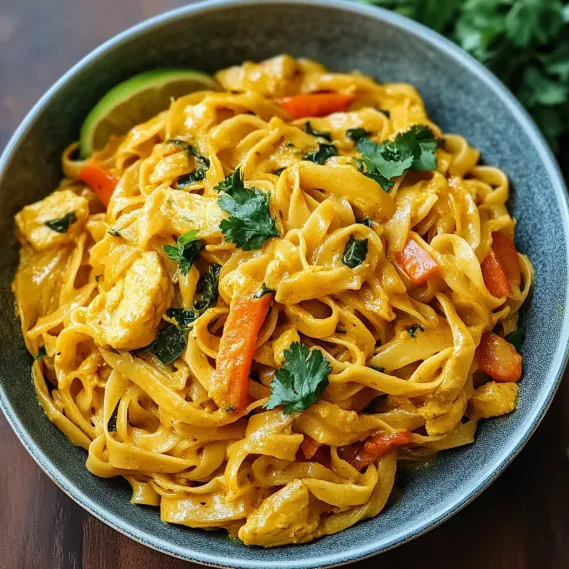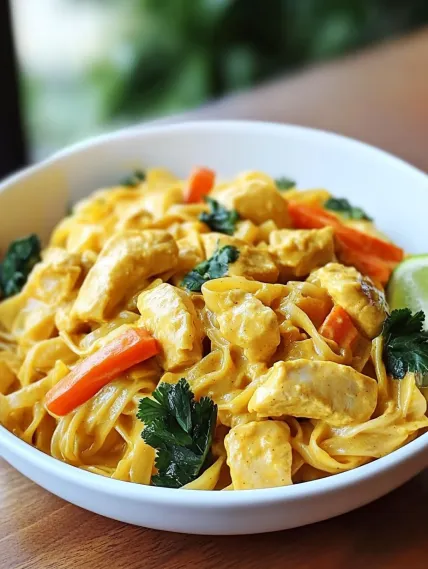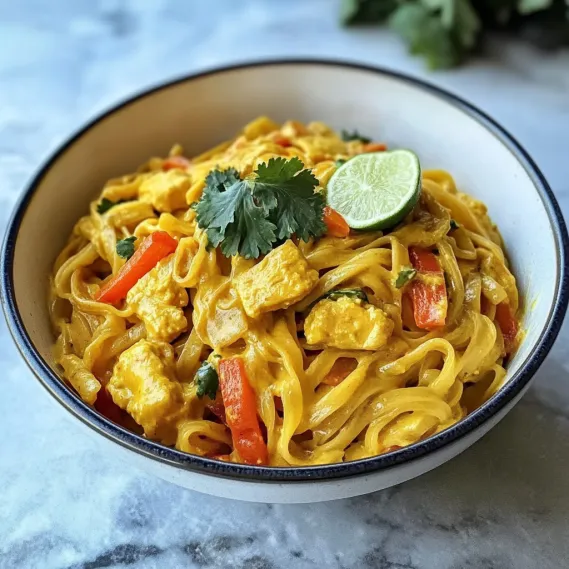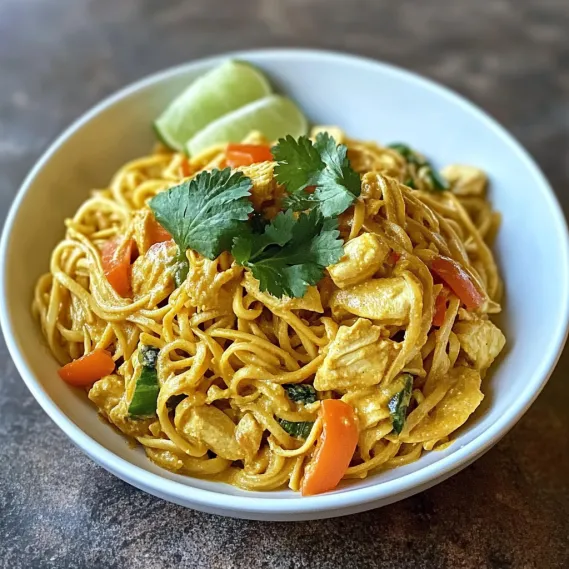 Pin
Pin
These 15-minute Yellow Curry Noodles combine creamy coconut milk with vibrant curry flavors, tender rice noodles, and colorful vegetables. Every bite delivers a perfect balance of warmth, spice, and texture. This dish saves time without sacrificing flavor, making it ideal for busy weeknights when you want something satisfying that doesn't keep you in the kitchen.
I discovered this recipe during a particularly hectic work week when I needed quick, nourishing meals. What started as a simple pantry cleanout became our family's most requested weeknight dinner. Even my vegetable-resistant children eagerly devour these noodles, making it a true winner in our household.
Essential Ingredients and Selection Tips
- Rice Noodles: Choose flat or thin varieties based on preference. Use what's in season.
- Yellow Curry Paste: Mae Ploy and Maesri brands offer authentic taste. Light versions work but produce thinner consistency.
- Coconut Milk: Full-fat creates the creamiest sauce. Light versions work but produce thinner consistency.
- Fresh Vegetables: Colorful bell peppers, carrots, and snap peas add nutrition and texture. Use what's in season.
- Fresh Aromatics: Ginger and garlic bring essential brightness. Don't substitute powdered versions if possible.
I've found that adding a tablespoon of peanut butter to the curry sauce creates an even richer flavor profile, reminiscent of my favorite Thai restaurant. This small addition brings depth and complexity that makes these quick noodles taste like they've been simmering for hours.
Detailed Cooking Instructions
- Step 1: Prepare the Noodles
- Fill a large pot with water and bring to a boil over high heat. Add 8 ounces of rice noodles and cook according to package instructions, typically 3-4 minutes until just tender but still firm. Immediately drain and rinse under cold water to stop cooking and prevent sticking.
- Step 2: Sauté the Aromatics
- Heat 1 tablespoon of olive oil in a large wok or skillet over medium heat until shimmering. Add 1 diced small onion and cook for 2-3 minutes until softened and translucent, then add 2 minced garlic cloves and 1 tablespoon freshly grated ginger, cooking for another minute until fragrant but not browned.
- Step 3: Develop the Curry Base
- Add 2 tablespoons yellow curry paste to the aromatics, stirring constantly to coat the onion mixture and prevent burning. Cook for 1-2 minutes until the paste darkens slightly and becomes aromatic, which helps develop deeper flavor in the final dish and releases the essential oils from the spices.
- Step 4: Create the Perfect Sauce
- Pour in one 14-ounce can of coconut milk, 1 tablespoon soy sauce, and 1 tablespoon sugar, whisking to fully incorporate the curry paste into the liquid. Bring the mixture to a gentle simmer, allowing it to cook for 2-3 minutes until it begins to thicken slightly and the flavors start to meld together.
- Step 5: Combine Everything
- Add 2 cups of mixed vegetables to the simmering sauce, cooking just until tender-crisp, about 3-5 minutes depending on the vegetables used. Gently fold in the prepared rice noodles, tossing to thoroughly coat with the curry sauce, then remove from heat and garnish with fresh cilantro and lime wedges before serving immediately.

I learned the importance of proper filling consistency through much trial and error. My first attempts were too runny, resulting in a soggy bottom crust that couldn't support the filling. Now I make sure to let the filling thicken properly and cool slightly before assembly, which makes all the difference in the final texture. My family notices and appreciates this attention to detail, especially my husband who initially preferred restaurant pies but now requests this recipe regularly.

The Perfect Weeknight Solution
This pie has become our Sunday dinner tradition during the colder months. There's something deeply satisfying about the ritual of preparing it while the family gathers around, drawn by the aromatic promise of comfort to come. I often prepare the filling in the morning, letting the flavors develop throughout the day before assembling and baking just before dinner. The anticipation builds as the pastry puffs and turns golden in the oven, filling the house with an irresistible aroma that signals the delicious flavors to come.
Versatile Meal-Planning Hero
As grocery prices have increased, this pie has become even more valuable in our meal planning. The ingredients are affordable staples that stretch to feed many hungry mouths. I often find ground beef on sale and portion it specifically for this recipe. Potatoes and onions are inexpensive staples, and puff pastry, while not the cheapest ingredient, transforms these humble components into something that feels special and celebratory. When unexpected guests joined us for dinner last month, I simply added extra potatoes and vegetables to extend the filling, and no one left the table hungry. The pie's ability to satisfy at a reasonable cost makes it a true kitchen hero during tight financial times.
Perfect for Sharing and Gifting
The communal nature of this pie makes it my go-to dish for supporting friends and neighbors through life's challenges and celebrations. When my neighbor underwent surgery, I delivered a fully baked pie that her family could easily reheat. For new parents in our community, I provide unbaked pies with baking instructions, offering them a home-cooked meal requiring minimal effort. These pies have become my signature contribution to our neighborhood, creating connections through shared food experiences. The grateful messages I receive confirm that this simple dish brings not just nourishment but also comfort during times of need, reinforcing my belief in food's power to convey care and support.
Chef's Helpful Tips
- For extra flavor, deglaze the pan with a splash of Irish stout beer when adding the broth
- Create individual hand pies for portable lunches or potluck contributions
- Add a teaspoon of Worcestershire sauce to the filling for additional umami depth
- Grade a little Irish cheddar into the filling for a subtle cheese undertone
- For an impressive presentation, use cookie cutters to create decorative shapes from pastry scraps to place on top of the pie
I've been making variations of this pie for over a decade, constantly refining the technique. The most significant improvement came when I started using the broiler to finish the salmon, creating that perfect balance of crisp exterior and tender, juicy interior.

This Yellow Curry Noodles recipe proves that sometimes the most memorable meals come from honoring simple ingredients with straightforward techniques that allow their natural qualities to shine through.
Recipe FAQs
- → Can I make this recipe gluten-free?
- Yes, this recipe is easy to make gluten-free. Simply substitute regular soy sauce with tamari or coconut aminos, and double-check that your curry paste doesn't contain any gluten ingredients (most Thai brands are naturally gluten-free, but it's always good to verify).
- → What vegetables work best in this curry noodle dish?
- The beauty of this recipe is its flexibility. Bell peppers, carrots, snap peas, broccoli, zucchini, and baby corn all work wonderfully. For quicker cooking, slice vegetables thinly and consistently. You can also add leafy greens like spinach or bok choy in the last minute of cooking.
- → Can I add protein to these noodles?
- Absolutely! Tofu, chicken, shrimp, or thinly sliced beef all pair nicely with these curry noodles. For tofu, press and cube it, then pan-fry before adding the vegetables. For meat or shrimp, cook them first in the skillet until almost done, then remove and add back in with the noodles at the end.
- → Where can I find yellow curry paste?
- Yellow curry paste is available in the international or Asian section of most large supermarkets. You can also find it at Asian grocery stores or online. Popular brands include Mae Ploy and Thai Kitchen. If you can't find yellow curry paste specifically, you can substitute with red curry paste plus 1/2 teaspoon of ground turmeric.
- → Can I make this dish less spicy?
- Yes, to reduce the spiciness, use less curry paste (start with 1 tablespoon instead of 2) and use full-fat coconut milk, which helps mellow the heat. You can also add a bit more sugar to balance the spice. Conversely, if you like it spicier, add a sliced Thai chili or some crushed red pepper flakes.
